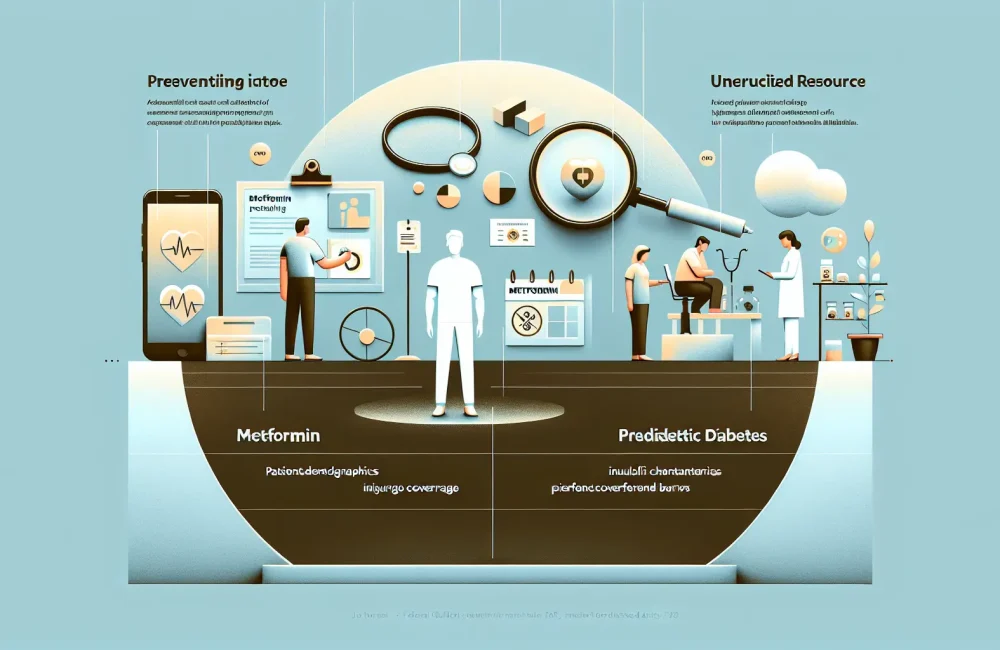By CAFMI AI From Journal of General Internal Medicine
Low Metformin Prescription Rates in FQHCs
Prediabetes represents a crucial opportunity for preventing the onset of type 2 diabetes, especially in vulnerable populations served by Federally Qualified Health Centers (FQHCs). Despite robust evidence supporting metformin’s role in reducing progression to diabetes among high-risk individuals, metformin remains significantly underutilized in these settings. This retrospective cohort study evaluated electronic health records from a national network of FQHCs, encompassing 45,000 adults aged 18 to 79 diagnosed with prediabetes between 2017 and 2023. Alarmingly, only 7% of these patients received at least one metformin prescription. Analysis revealed variations in prescribing patterns influenced by patient demographics and clinical characteristics. Younger patients were more likely to be prescribed metformin compared to older adults, and those with higher body mass index (BMI), especially those with BMI ≥ 35, had higher prescription rates. Racial and ethnic disparities were observed as well, signaling persistent systemic inequities that can influence treatment access and decisions. Furthermore, patients with documented cardiovascular disease or renal impairment were less likely to receive metformin prescriptions, likely reflecting clinical caution given contraindications and safety concerns. The study also highlighted insurance coverage as a critical factor; uninsured patients were significantly less likely to receive metformin. This gap in prescribing underscores multiple barriers at both patient and system levels preventing optimal use of metformin for diabetes prevention within FQHC populations.
Clinical Implications and Barriers to Metformin Use
The low rate of metformin prescribing for prediabetes in FQHCs has substantial clinical implications. Prediabetes patients, particularly those with elevated BMI and other risk factors, remain vulnerable to progressing to type 2 diabetes without effective interventions. Metformin has demonstrated consistent efficacy in large trials and guideline endorsements as a safe, cost-effective pharmacologic option to delay or prevent diabetes onset in high-risk individuals. However, real-world uptake remains inadequate, especially in safety-net settings. Barriers identified by this study include age-related prescribing tendencies, whereby older patients are less likely to receive metformin, potentially due to concerns over polypharmacy or comorbidities. Additionally, the presence of cardiovascular or kidney comorbidities limits prescribing despite the possibility that some patients might still benefit if carefully monitored. Insurance status emerges as a critical determinant affecting access to this preventive treatment, with uninsured or underinsured patients facing challenges to medication affordability and continuity. Racial and ethnic disparities in prescription rates suggest that social determinants of health and provider biases could also affect equitable care delivery. Addressing these multifactorial barriers requires targeted clinician education, improved risk stratification tools, and system-level initiatives to expand access, including medication assistance programs and policy advocacy aimed at reducing cost and coverage gaps. Counseling and shared decision-making with patients about the benefits and safety profile of metformin can promote adherence and highlight the importance of lifestyle modification alongside pharmacotherapy.
Strategies for Improving Metformin Uptake and Diabetes Prevention Outcomes
To improve diabetes prevention outcomes among prediabetes patients in FQHCs, systemic and patient-centered strategies are essential. First, clinical workflows should incorporate routine screening and risk assessment for prediabetes with timely identification of candidates for metformin therapy. Integration of decision support tools within electronic health records can prompt providers to consider metformin when appropriate, based on BMI, age, and comorbid conditions. Education programs aimed at clinicians can demystify concerns related to metformin safety in older adults and those with mild renal impairment, empowering providers to make evidence-based prescribing decisions. Additionally, addressing insurance-related barriers through connecting patients to medication assistance programs or exploring institution-level subsidizing can improve access. Patient education is equally vital, emphasizing how metformin works in conjunction with diet and exercise to delay type 2 diabetes progression and reducing fears about side effects. Follow-up visits should emphasize monitoring for efficacy and adverse effects to optimize adherence and treatment outcomes. Collaborations with pharmacists and care coordinators can support this process by facilitating medication management and patient engagement. Ultimately, multi-pronged interventions tailored for the unique patient population in FQHCs—taking into account social determinants of health—could increase metformin utilization. Enhancing access to metformin in prediabetes management aligns with national diabetes prevention goals and can reduce health disparities by preventing progression to diabetes in underserved communities.
Read The Original Publication Here






